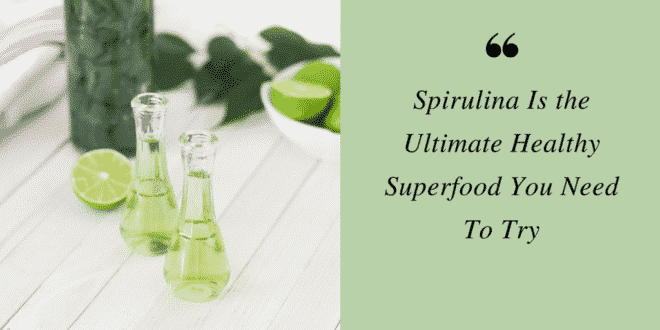Photo by Alexander Mils on Unsplash
By Jenn Samson Contributing Author, a passionate freelance writer, and editor
When you think of the best superfoods to add to your smoothie, you’re probably thinking about healthy greens and antioxidant-rich berries. However, that narrow definition of superfood could be preventing you from trying out one of the most powerful superfoods. Spirulina has been a health food additive for decades, and it was a popular nutritional additive even in ancient cultures.
For those unfamiliar with spirulina, it is a form of blue-green algae. Don’t let that turn you off, however. Just because it shares genetic components with the unattractive growth you see in some lakes or pools doesn’t mean it has nothing to offer you. Spirulina is an incredible nutritional resource, especially for vegetarians and vegans.
Spirulina Is High in Key Nutrients
Spirulina is one of the only plant-based sources of complete protein. In other words, spirulina contains all of the necessary amino acids, unlike most grains and other plant-based foods. The fact that spirulina, in powdered, dried form, contains 60 to 70% protein isn’t the only benefit of this plant-based food.
Spirulina is also rich in iron, calcium, and magnesium. It is also an excellent source of the Vitamins A, K, and E. The combination of iron and protein is particularly important, as it can help vegans and strict vegetarians stave off anemia, also known as low iron.
Spirulina Can Be Ethically Harvested
Many of the most popular superfoods create issues in other countries. For example, quinoa, a traditional grain from Bolivia, has become incredibly popular in other countries. Long a staple of subsistence farmers in its homeland, quinoa is now so expensive on the market that local farmers can’t enjoy this staple of their traditional diet. Other popular superfoods may require environmentally damaging farming, harvesting, or processing techniques.
Spirulina is readily available on several continents and occurs naturally with a little help from human farmers. More importantly, it is easy to process and dry. In fact, many enthusiastic spirulina consumers can grow spirulina at home as a low-cost, low-input food source. Once the algae grow, they are harvested, dried, and powdered.
Spirulina Is Easy To Add To Your Diet
Unlike some superfoods, which can be difficult to incorporate into your diet, spirulina couldn’t be easier to include in your daily foods. Most people choose to add it to their smoothies or juices. Just one tablespoon of powdered spirulina contains roughly 10 grams of protein. You can also sprinkle it on grains, salads, or other dishes before serving.
In other words, this green superfood packs a huge protein punch without needing to overwhelm the other ingredients you use. If working with powdered spirulina turns you off, there are multiple products already formatted and available for purchase on the market. In fact, you can find shake bases that have spirulina protein in them, along with attractive flavourings, like chocolate or strawberry.
Spirulina is an incredible nutritional resource. It can help people who are using changes to their diet to fight cancer or autoimmune conditions. It can also help vegans and vegetarians ensure a more well-rounded diet. If you are curious about spirulina, there is no time like the present to try it out and see how this superfood might benefit your lifestyle.
Jenn Samson is a freelance writer and editor. She used to work in PR but has been embracing the freelance life for many years now. Outside of work, she enjoys cooking, hiking and traveling to Europe as much as possible.







